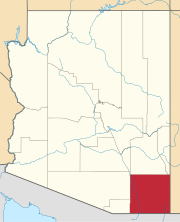
Cochise County is a county in the southeastern corner of the U.S. state of Arizona. It is named after Cochise, a Chiricahua Apache who was a key war leader during the Apache Wars.

Sierra Vista is a city in Cochise County, Arizona, United States. According to the 2020 Census, the population of the city is 45,308, and is the 27th most populous city in Arizona. The city is part of the Sierra Vista-Douglas Metropolitan Area, with a 2010 population of 131,346. Fort Huachuca, a U.S. Army post, has been incorporated and is located in the northwest part of the city. Sierra Vista is bordered by the cities of Huachuca City and Whetstone to the north and Sierra Vista Southeast to the South.
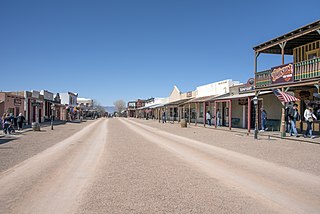
Tombstone is a city in Cochise County, Arizona, United States, founded in 1879 by prospector Ed Schieffelin in what was then Pima County, Arizona Territory. It became one of the last boomtowns in the American frontier. The town grew significantly into the mid-1880s as the local mines produced $40 to $85 million in silver bullion, the largest productive silver district in Arizona. Its population grew from 100 to around 14,000 in less than seven years. It is best known as the site of the Gunfight at the O.K. Corral and draws most of its revenue from tourism. The city had a permanent population of 1,308, according to the 2020 census.

Thatcher is a town in Graham County, Arizona, United States. According to the 2010 Census, the population of the town is 4,865. It is part of the Safford Micropolitan Statistical Area.
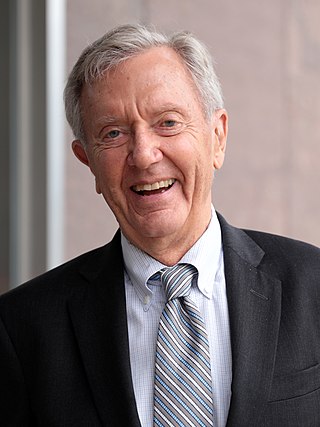
Bruce Edward Babbitt is an American attorney and politician who served as the 47th United States Secretary of the Interior from 1993 to 2001 under President Bill Clinton. He previously served as the 16th governor of Arizona from 1978 to 1987 and was a candidate for President of the United States in the 1988 Democratic primaries.
Asa Alonso Allen, better known as A. A. Allen, was an American Pentecostal evangelist known for his faith healing and deliverance ministry. He was, for a time, associated with the "Voice of Healing" movement founded by Gordon Lindsay. Allen died of alcoholism and liver failure in a coma at the age of 59 in San Francisco, California, and was buried at his ministry headquarters in Miracle Valley, Arizona.
Walter Vinson Grant Jr. is an American televangelist whose ministry has been based in the Greater Dallas area.
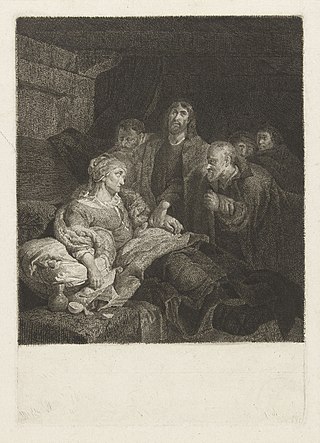
Matthew 8:14 is the fourteenth verse of the eighth chapter of the Gospel of Matthew in the New Testament. This verse and the following verse constitute a "simple short story" in which Jesus heals Peter's mother-in-law.

Matthew 8:15 is the fifteenth verse in the eighth chapter of the Gospel of Matthew in the New Testament which relates the Healing the mother of Peter's wife.
Donald Lee Stewart is an American Pentecostal minister and purported faith healer. He is a televangelist who hosts Power and Mercy on Black Entertainment Television, The Word Network, and other television channels. He is the successor to the late A. A. Allen's organization.

Harry Cornwall Wheeler was an Arizona lawman who was the third captain of the Arizona Rangers, as well as the sheriff of Cochise County, serving from 1912 into 1918. He is known as the lead figure in the illegal mass kidnapping and deportation of some 1200 miners and family members, many of them immigrants, from Bisbee, Arizona to New Mexico in 1917. Beginning on July 12, 1917, he took total control of the town of Bisbee, controlling access and running kangaroo courts that deported numerous people.

Pearce, Arizona, and Sunsites, Arizona, are adjacent unincorporated communities in the Sulphur Springs Valley of Cochise County, Arizona, United States. The two communities are often referred to as Pearce–Sunsites, Pearce/Sunsites, or Pearce Sunsites.
Robert William “R.W.” Schambach was an American televangelist, pastor, Word of Faith minister of the Word and author. His television program, Power Today, can be seen on the DayStar Christian TV network as well as over the internet in streaming podcasts.

The Cochise County Cowboys is the modern name for a loosely associated group of outlaws living in Pima and Cochise County, Arizona in the late 19th century. The term "cowboy", as opposed to "cowhand," had only begun to come into wider usage during the 1870s. In that place and time, "cowboy" was synonymous with "cattle rustler". Such thieves frequently rode across the border into Mexico and stole cattle from Mexican ranches that they then drove back across the border to sell in the United States. Some modern writers consider them to be an early form of organized crime in America.

Cochise County in southeastern Arizona was the scene of a number of violent conflicts in the 19th-century and early 20th-century American Old West, including between white settlers and Apache Indians, between opposing political and economic factions, and between outlaw gangs and local law enforcement. Cochise County was carved off in 1881 from the easternmost portion of Pima County during a formative period in the American Southwest. The era was characterized by rapidly growing boomtowns, the emergence of large-scale farming and ranching interests, lucrative mining operations, and the development of new technologies in railroading and telecommunications. Complicating the situation was staunch resistance to white settlement from local Native American groups, most notably during the Apache Wars, as well as Cochise County's location on the border with Mexico, which not only threatened international conflict but also presented opportunities for criminal smugglers and cattle rustlers.

The Gleeson gunfight, or the Gleeson shootout, was one of the last gunfights in the Old West, having occurred during the transition period between the "Old" and the "New." On March 5, 1917, the sheriff of Cochise County, Harry C. Wheeler, and his deputy, Lafe Gibson, were ambushed by a gang of Mexican alcohol smugglers near the town of Gleeson, Arizona. During the battle that followed, Wheeler and Gibson fought off the attackers and confiscated their alcohol, wounding at least one man in the process.
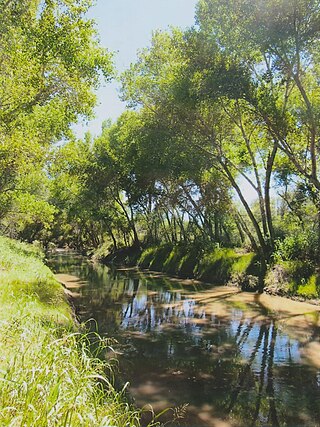
Palominas is a census-designated place located along the San Pedro River in the southern portion of Cochise County in the state of Arizona, United States. Palominas is located very close to the community of Miracle Valley along Arizona State Highway 92. The population of Palominas as of the 2020 U.S. Census was 222.
The Miracle Valley shootout was a confrontation between members of the Christ Miracle Healing Center and Church (CMHCC) and Cochise County law enforcement that occurred in Miracle Valley, Arizona, on October 23, 1982. A variety of incidents with law enforcement in 1982 culminated when a large group of church members confronted local sheriff's deputies and state law enforcement officers attempting to serve bench warrants for the arrest of three members of the church. In the ensuing melee, two church members were killed and seven people were injured. One church member and one law enforcement officer died later, both deaths possibly due to injuries sustained that day.
On August 31, 2001, a shootout occurred in Stevenson Ranch, an unincorporated community in Santa Clarita Valley, California. It resulted in the immediate deaths of James Allen Beck, a convicted felon, and Hagop "Jake" Kuredjian, a sheriff's deputy. Ten years later, ATF agent Jeff Ryan committed suicide resulting from the traumatic ordeal.















